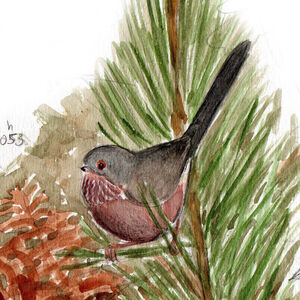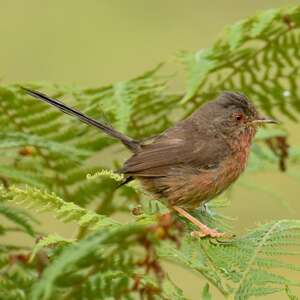Dartford Warbler
Curruca undata - Fauvette pitchou
Identification
Very difficult to observe, the Dartford Warbler is nevertheless a bird that can not be confused due to its small size, its very long tail which it always keeps raised and very often deployed. At first sight, it gives the impression of being blackish. On closer inspection, the adult male is appreciated for its gray-slate head and the grayish-brown back, sometimes dark brown. The lower parts have a purplish red hue that borders on violet. The tail is black with the edging of the feathers gray and the pair of outer rectrices decorated with a fine whitish border. The red-orange iris and the even more red orbital ring form a characteristic feature that is particularly visible despite the restless movements of this bird. The beak is blackish with the base of the lower mandible pinkish yellow. The tarses and feet are yellowish. The wings are very dark, almost black. In autumn, the chin and throat bear numerous small white spots.
The female's plumage is entirely lighter. The head is brown, not grey, and the rest of the upper parts are dark brown. The intense red-purple color is absent on the chest and one can at best detect a pinkish hue. The young warblers look more like the female than the male. The plumage of their upper parts displays an earthy hue, darker than that of adult females and its aspect is more uniform.
Pitchou means small in Provençal and evokes the tiny size of this bird.
Subspecific information 3 subspecies
- Curruca undata undata (Iberian Pen., s France and Italy)
- Curruca undata dartfordiensis (s England, w France and nw Spain)
- Curruca undata toni (nw Africa)
Foreign names
- Fauvette pitchou,
- Curruca rabilarga,
- toutinegra-do-mato,
- Provencegrasmücke,
- bujkáló poszáta,
- Provençaalse Grasmus,
- Magnanina comune,
- provencesångare,
- Vinsanger,
- penica hnedá,
- pěnice kaštanová,
- Provence-sanger,
- ruskokerttu,
- tallareta cuallarga,
- Busksöngvari,
- pokrzewka kasztanowata,
- garastes ķauķis,
- palčja penica,
- Провансальская славка,
- オナガムシクイ,
- 波纹林莺,
- provencesångare,
- 波紋林鶯,
Voice song and call
The Dartford Warbler's song somewhat resembles the song of the Meadow Pipit, which occupies the same biotope, but is shorter and less intense. It's sweet, pleasant, sometimes sparkling, and is uttered from the top of a tree as well as other higher spots such as electric wires. In addition to its usual song which can be heard at any time of the year, it emits a sharp and metallic alarm call, tchrrr, while moving around the vegetation and quickly escaping from cover to observe the intruder. If excited, it can produce a high-pitched and repetitive té-té-té-té. When felt to be watched as it approaches its nest, it emits a pleasant sound which can be transcribed as tcherr-chiui. The second part is very musical. The Dartford Warbler produces a great variety of sounds and their description can be very subjective.
Habitat
The Dartford Warbler breeds in Western Europe, throughout the Iberian Peninsula, the south and west of France, Italy and the Mediterranean Islands such as Sicily, Corsica and Sardinia.
Behaviour character trait
Dartford Warblers are very sensitive to weather conditions. When winters are harsh, in the northern areas of their range, mortality can be significant.
In southern England, there were 460 pairs in 1960-61, but after the 1963 winter, only 11 remained.The numbers have been steadily increasing since, reaching 70 pairs in 1970 and 560 in 1974. These statistics show the variation in population density. These fluctuations are likely not as drastic in the Iberian Peninsula and southern Europe, where the bird encounters milder temperatures and more favourable terrain and vegetation for shelter. Nevertheless, in winter there are some transient bird movements, with those living in altitude descending into valleys, along coasts, or in agricultural plains looking for better conditions. Widespread movement throughout the Peninsula takes place in winter, when the Dartford Warbler is found on the Balearic Islands, where it doesn't usually nest. A considerable number cross the Mediterranean straits to reach North Africa. A high concentration of these birds on the Moroccan coast between October and March could in part be of European origin, as a massive presence of these birds during this period of cannot be exclusively explained by African species' gathering.Flight
The Dartford Warbler often sings in flight while gaining altitude. Its silhouette and somewhat hopping flight evokes the Long-tailed Tit.
Dietfeeding habits
Its diet is fundamentally insectivorous. It captures small beetles, all sizes of lepidoptera and their caterpillars, Diptera (meadow dwile-flies, flies, chironomidae which are small insects very similar to mosquitoes) etc. Spiders, so abundant among thorny plants, can constitute a good resource during the winter. Vegetable matter probably should not be excluded from its diet during autumn and winter. The seeds of grasses and wild fruits seem to concentrate small groups of Dartford Warblers.
Reproduction nesting
In March, the males already start their first display flights. In the early days of April, except in case of rain, it is common to hear their uninterrupted singing which is short and low intensity, but can still be heard from far away. As each couple occupies a very small territory, the males perform modest exhibitions, flying with outstretched wings and tail, and landing while swelling their facial and head feathers, which seem bigger for such a small bird. In the south of Europe, the start of breeding is closely linked to temperature and rainfall. The nests that the males build are simply some dry tufts of grass accumulated together so that it can be sometimes difficult to know if it is truly a nest or just some random vegetation.
Most of them are found in low heather (Calluna vulgaris) or in thorny bushes, some of them, rarely, in brambles. The height varies: very low in heather, around 25 cm, between 40 cm and 1,30 m in thorny bushes, and the average height is between 50 and 80 cm in brambles.The female does most of the work, arranging and reorganising the dry grass and moss on the structure previously setup by the male. Inside it is filled with dry heather stalks, rootlets, fine grass, wool and some feathers. She also adds hair, horsehair and spider webs which cover and compress the edges of the nest. From 10th April, the nests are ready in many places, but the eggs don't generally begin to be laid until the second fortnight of the month.Normally composed of 3-4 eggs, occasionally 5, six-egg clutches are exceptional. Their color is a pale greenish-gray or beige with small olive-brown, ash-gray or reddish-brown spots, usually spread out across the entire surface, but sometimes concentrated at one end of the egg. Many Dartford Warblers do not start egg-laying until the first week of May. Incubation is almost entirely done by the female and is rarely relieved by the male. The chicks, hatching after 12 or 13 days, are born without feathers and with a very dark skin. The inside of their mouths are pale yellow with two black spots at the base of the tongue. Both parents take care of the feeding of the young, gorging them on insects and especially small caterpillars. The chicks leave the nest after 12 or 13 days, but may anticipate their departure if disturbed or if subjected to too much heat. Dartford Warblers carry out two broods per season. The eventuality of a third brood is possible if the conditions are favorable.
Threats - protection
IUCN conservation status
concern
in the Wild
threatened
evaluated
This species should be monitored in France. It is vulnerable in Europe. The stronghold for the species, located on the Iberian Peninsula, is seeing a degradation of favorable habitats leading to a slow decline in numbers.
Sources of information
- IOC World Bird List (v15.1), Gill, F and D Donsker (Eds). 2025-12-07.
Other sources of interest
 Specification sheet created on
28/10/2023 by Alexandre Knochel with help of Georges Olioso and Daniel Le-Dantec
Specification sheet created on
28/10/2023 by Alexandre Knochel with help of Georges Olioso and Daniel Le-DantecTranslation by AI Oiseaux.net
© 1996-2026 Oiseaux.net
- Accipitriformes
- Aegotheliformes
- Anseriformes
- Apodiformes
- Apterygiformes
- Bucerotiformes
- Caprimulgiformes
- Cariamiformes
- Casuariiformes
- Charadriiformes
- Ciconiiformes
- Coliiformes
- Columbiformes
- Coraciiformes
- Cuculiformes
- Eurypygiformes
- Falconiformes
- Galliformes
- Gaviiformes
- Gruiformes
- Leptosomiformes
- Mesitornithiformes
- Musophagiformes
- Nyctibiiformes
- Opisthocomiformes
- Otidiformes
- Passeriformes
- Pelecaniformes
- Phaethontiformes
- Phoenicopteriformes
- Piciformes
- Podargiformes
- Podicipediformes
- Procellariiformes
- Psittaciformes
- Pterocliformes
- Rheiformes
- Sphenisciformes
- Steatornithiformes
- Strigiformes
- Struthioniformes
- Suliformes
- Tinamiformes
- Trogoniformes
































